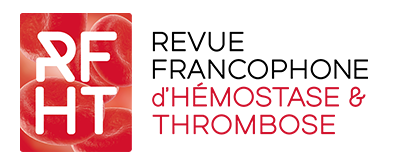RÉSUMÉ
Dix ans après la commercialisation des anticoagulants oraux directs (A0D), seul le dabigatran dispose en Europe d’un antidote spécifique, l’idarucizumab. Un antidote des xabans, l’andexanet-α, est mis sur le marché aux États-Unis depuis 2018. Contrairement à l’idarucizumab, l’andexanet-α possède un effet procoagulant, et n’a pas à ce jour prouvé sa supériorité en termes d’efficacité et de sécurité par rapport aux agents pro hémostatiques. Ces derniers incluent les concentrés de complexe prothrombique activés ou non, et sont proposés pour la gestion des AOD en cas d’hémorragie ou avant acte invasif urgent. D’autres antidotes des AOD sont en développement préclinique ou clinique, le plus avancé étant l’aripazine. Étant données les limites non négligeables de ces antidotes en développement, nous avons conçu, préparé et évalué un antidote qui neutralise les xabans sans interférer avec l’hémostase. Cet antidote consiste en un complexe (GDFXa-α2M) formé de facteur (F) Xa dépourvu de domaine Gla (GDFXa) séquestré par l’α2Macroglobuline (α2M). Les affinités des xabans pour GDFXa-α2M sont comparables à celles pour le FXa. Son efficacité a été vérifiée in vitro en présence de xabans, de dabigatran ou d’héparines et de ses dérivés par test de génération de fibrine, thromboélastométrie (Rotem) et tests chromogéniques. Son efficacité a également été vérifiée in vivo dans un modèle murin de saignement sans augmentation des D-dimères ou des complexes thrombine-antithrombine. Une molécule de deuxième génération est en cours de développement préclinique. Elle serait un nouvel antidote prometteur des AOD et dérivés hépariniques dépourvu d’effet anti- ou procoagulant.
MOTS CLÉS
antidote, dabigatran, GDFXa- α2Macroglobuline, xabans
ABSTRACT
Ten years after the marketing of direct oral anticoagulants (DOACs), only dabigatran has a specific antidote, idarucizumab, available in Europe. An antidote for xabans, andexanet-α, was approved in 2018 in the United States. Unlike idarucizumab, andexanet-α has a procoagulant effect and has not yet proven to be superior to prohaemostatic agents in terms of efficacy and safety. These agents include both activated and non-activated prothrombin complex concentrates and are proposed for the management of DOACs in the event of haemorrhage or prior to an urgent invasive procedure. Other antidotes to DOACs are in preclinical or clinical development, the most advanced being aripazine. Given the significant limitations of these antidotes, we have designed, prepared and evaluated an antidote that neutralizes xabans without interfering with hemostasis. This antidote consists of a complex (GDFXa-α2M) formed of factor (F) Xa lacking the Gla domain (GDFXa) sequestered by u2Macroglobuline. The affinities of xabans for GDFXa-α2M are comparable to those for FXa. Its efficacy has been verified in vitro in the presence of xabans, dabigatran or heparins and its derivatives by dot waveform assay, thromboelastometry (Rotem) and chromogenic assays. Its efficacy was also verified in vivo in a mouse bleeding model, and it did not increase D-dimers level or thrombin-anti-thrombin complexes. A second-generation molecule is in preclinical development and is believed to be a promising new antidote to DOACs and heparin derivatives without anti- or procoagulant effects.
KEYWORDS
antidote, dabigatran, GDFXa- α2Macroglobulin, xabans

